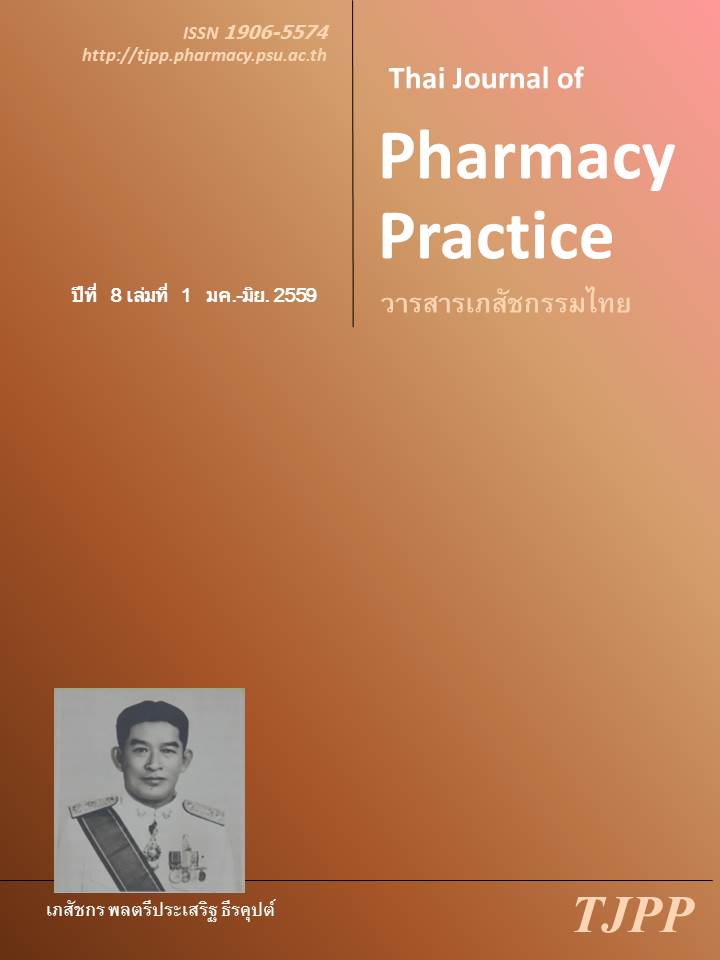ความชุกและลักษณะของภาวะความดันเลือดต่ำขณะเปลี่ยนอิริยาบถ ชนิดที่มีอาการทางคลินิกในผู้ป่วยไทย ที่เป็นโรคพาร์กินสัน
Main Article Content
บทคัดย่อ
วัตถุประสงค์: เพื่อศึกษาความชุกและลักษณะของภาวะความดันเลือดต่ำขณะเปลี่ยนอิริยาบถ (orthostatic hypotension) ชนิดที่มีอาการทางคลินิกในผู้ป่วยโรคพาร์กินสัน (PD) ชาวไทย วิธีการ: ตัวอย่าง คือ ผู้ป่วย PD จำนวน 100 คน ที่เข้ารับการรักษาในศูนย์ความเป็นเลิศด้านโรคพาร์กินสันและกลุ่มโรคความเคลื่อนไหวผิดปกติ โรงพยาบาลจุฬาลงกรณ์ ระหว่างเดือนพฤษภาคม - สิงหาคม 2558 ผู้วิจัยวัดความดันเลือดของผู้ป่วยในท่านั่งหรือท่านอนเทียบกับท่ายืนและประเมินอาการทางคลินิกในช่วง 1 สัปดาห์ที่ผ่านมาด้วยแบบสัมภาษณ์ OHQ (Orthostatic Hypotension Questionnaire) หากความดันช่วงหัวใจบีบ (SBP) ลดลง ≥ 20 มิลลิเมตรปรอท และ/หรือความดันช่วงหัวใจคลาย (DBP) ลดลง ≥ 10 มิลลิเมตรปรอท ภายใน 3 นาทีหลังจากยืน จะเข้าเกณฑ์มีภาวะ orthostatic hypotension (OH) และหากมีคะแนนจาก OHQ ร่วมด้วย จะจัดเป็น OH ที่มีอาการทางคลินิก ผลการวิจัย: ผู้ป่วยมีอายุ 65.5 ± 11.6 ปี ผลการวิจัยสามารถจำแนกผู้ป่วยตามความดันเลือดที่เปลี่ยนแปลงเมื่อเปลี่ยนเป็นท่ายืนและตามคะแนนจาก OHQ เป็น 4 ลักษณะ ได้แก่ 1) OH ที่มีอาการทางคลินิก คือ ความดันเลือดลดลงตามเกณฑ์ OH และมีอาการ OH (ร้อยละ 18) 2) ผู้ป่วยที่ความดันเลือดไม่ได้ลดลงตามเกณฑ์ OH และไม่มีอาการ OH (ร้อยละ 36) 3) ผู้ป่วยที่ความดันเลือดลดลงตามเกณฑ์ OH แต่ไม่มีอาการ OH (ร้อยละ 4) และ 4) ผู้ป่วยที่ความดันเลือดไม่ได้ลดลงตามเกณฑ์ OH แต่มีอาการ OH (ร้อยละ 42) การศึกษานี้พบความชุกของภาวะ OH และ OH ที่มีอาการทางคลินิกในผู้ป่วย PD ร้อยละ 22 (ช่วงความเชื่อมั่นที่ร้อยละ 95: 14-30) และร้อยละ 18 (ช่วงความเชื่อมั่นที่ร้อยละ 95: 10-26) ตามลำดับ อาการทางคลินิกของ OH คือ เวียนศีรษะ มึนศีรษะ เป็นลม การมองเห็นผิดปกติ ไม่มีเรี่ยวแรง เหนื่อยล้า และไม่สบายที่ศีรษะหรือคอ สรุป: สามารถพบภาวะ OH ได้ในผู้ป่วย PD และผู้ป่วยจำนวนหนึ่งมีอาการทางคลินิกร่วมด้วย การติดตามวัดความดันเลือดและการประเมินด้วยแบบสัมภาษณ์ OHQ ช่วยเพิ่มโอกาสในการค้นพบผู้ป่วยที่มีภาวะ OH และ OH ที่มีอาการทางคลินิกได้
Article Details
ผลการวิจัยและความคิดเห็นที่ปรากฏในบทความถือเป็นความคิดเห็นและอยู่ในความรับผิดชอบของผู้นิพนธ์ มิใช่ความเห็นหรือความรับผิดชอบของกองบรรณาธิการ หรือคณะเภสัชศาสตร์ มหาวิทยาลัยสงขลานครินทร์ ทั้งนี้ไม่รวมความผิดพลาดอันเกิดจากการพิมพ์ บทความที่ได้รับการเผยแพร่โดยวารสารเภสัชกรรมไทยถือเป็นสิทธิ์ของวารสารฯ
เอกสารอ้างอิง
2. Bhidayasiri R, Wannachai N, Limpabandhu S, Choeytim S, Suchonwanich Y, Tananyakul S, et al. A national registry to determine the distribution and prevalence of Parkinson's disease in Thailand: implications of urbanization and pesticides as risk factors for Parkinson's disease. Neuroepidemiology. 2011;37:222-30.
3. Bhidayasiri R, Truong DD. Therapeutic strategies for nonmotor symptoms in early Parkinson's disease: the case for a higher priority and stronger evidence. Parkinsonism Relat Disord. 2012;18 Suppl 1:S110-3.
4. Velseboer DC, de Haan RJ, Wieling W, Goldstein DS, de Bie RM. Prevalence of orthostatic hypotension in Parkinson's disease: a systematic review and meta-analysis. Parkinsonism Relat Disord. 2011;17:724-9.
5. Isaacson SH, Skettini J. Neurogenic orthostatic hypotension in Parkinson's disease: evaluation, management, and emerging role of droxidopa. Vasc Health Risk Manag. 2014;10:169-76.
6. Poon IO, Braun U. High prevalence of orthostatic hypotension and its correlation with potentially causative medications among elderly veterans. J Clin Pharm Ther. 2005;30:173-8.
7. Milazzo V, Stefano CD, Servo S, Crudo V, Fulcheri C, Maule S, et al. Drugs and orthostatic hypotension: evidence from literature. J Hypertens 2012;1:104.
8. Mussi C, Ungar A, Salvioli G, Menozzi C, Bartoletti A, Giada F, et al. Orthostatic hypotension as cause of syncope in patients older than 65 years admitted to emergency departments for transient loss of consciousness. J Gerontol A Biol Sci Med Sci. 2009 ;64: 801-6.
9. Shaw BH, Claydon VE. The relationship between orthostatic hypotension and falling in older adults. Clin Auton Res. 2014;24:3-13.
10. Michalowska M, Krygowska-Wajs A, Jedynecka U, Sobieszek A, Fiszer U. Analysis of causes for falls in people with Parkinson's disease. Neurol Neurochir Pol. 2002;36:57-68.
11. Eigenbrodt ML, Rose KM, Couper DJ, Arnett DK, Smith R, Jones D. Orthostatic hypotension as a risk factor for stroke: the atherosclerosis risk in communities (ARIC) study, 1987-1996. Stroke. 2000;31:2307-13.
12. Elmstáh l, Rosén I. Postural hypotension and EEG variables predict cognitive decline: results from a 5-year follow-up of healthy elderly women. Dement Geriatr Cogn Disord. 1997;8:180-7.
13. Fedorowski A, Stavenow L, Hedblad B, Berglund G, Nilsson PM, Melander O. Orthostatic hypotension predicts all-cause mortality and coronary events in middle-aged individuals (The Malmo Preventive Project). Eur Heart J. 2010;31:85-91.
14. Perez-Lloret S, Rey MV, Fabre N, Ory F, Spampinato U, Senard JM, et al. Factors related to orthostatic hypotension in Parkinson's disease. Parkinsonism Relat Disord. 2012;18:501-5.
15. Ha AD, Brown CH, York MK, Jankovic J. The prevalence of symptomatic orthostatic hypotension in patients with Parkinson's disease and atypical parkinsonism. Parkinsonism Relat Disord. 2011; 17: 625-8.
16. Senard JM, Rai S, Lapeyre-Mestre M, Brefel C, Rascol O, Rascol A, et al. Prevalence of orthostatic hypotension in Parkinson's disease. J Neurol Neurosurg Psychiatry. 1997;63:584-9.
17. Sithinamsuwan P, Orrawanhanothai P, Thithum K, Udommongkol C, Chairangsaris P, Chinvarun Y, et al. Orthostatic hypotension: a non-motor compli- cation assessment in 82 patients with idiopathic Parkinson's disease in Phramongkutklao Hospital. J Med Assoc Thai. 2010;93(Suppl 6):S93-9.
18. Tomlinson CL, Stowe R, Patel S, Rick C, Gray R, Clarke CE. Systematic review of levodopa dose equivalency reporting in Parkinson's disease. Mov Disord. 2010;15;25:2649-53.
19. Topouchian J, Agnoletti D, Blacher J, Youssef A, Ibanez I, Khabouth J, et al. Validation of four automatic devices for self-measurement of blood pressure according to the international protocol of the European Society of Hypertension. Vasc Health Risk Manag. 2011;7:709-17.
20. Freeman R, Wieling W, Axelrod FB, Benditt DG, Benarroch E, Biaggioni I, et al. Consensus statement on the definition of orthostatic hypotension, neurally mediated syncope and the postural tachycardia syndrome. Clin Auton Res. 2011;21:69-72.
21. Kaufmann H, Malamut R, Norcliffe-Kaufmann L, Rosa K, Freeman R. The Orthostatic Hypotension Questionnaire (OHQ): validationof a novel symptom assessment scale. Clin Auton Res. 2012 22:79-90.
22. Vara Gonzalez L, Dominguez Rollan R, Fernandez Ruiz M, Josa Fernandez B, Ruiz Izquierdo F, Zabalo Amezqueta A, et al. Prevalence of orthostatic hypotension in elderly hypertensive patients in primary care. Aten Primaria. 2001; 28: 151-7.
23. Bordier P, Garrigue S, Lanusse S, Margaine J, Robert F, Gencel L, et al. Cardiovascular effects and risk of syncope related to donepezil in patients with Alzheimer's disease. CNS drugs. 2006; 20: 411-7.
24. Tayeb HO, Yang HD, Price BH, Tarazi FI. Pharmacotherapies for Alzheimer's disease: Beyond cholinesterase inhibitors. Pharmacol Ther. 2012;134:8-25.
25. Sanchez-Ferro A, Benito-Leon J, Gomez-Esteban JC. The management of orthostatic hypotension in Parkinson's disease. Front Neurol. 2013;4: (64)doi: 10.3389/fneur.2013.00064.
26. Bae HJ, Cheon SM, Kim JW. Autonomic dysfunctions in parkinsonian disorders. J Mov Disord 2009;2:72-7.
27. Hauser RA, Isaacson S, Lisk JP, Hewitt LA, Rowse G. Droxidopa for the short-term treatment of symptomatic neurogenic orthostatic hypotension in Parkinson's disease (nOH306B). Mov Disord. 2015 15;30:646-54.


